|
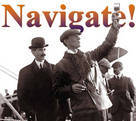
 Up
Up 
 The Decade
The Decade
After

(You are here.)
 Down
Down




  Need
to Need
to
find your
bearings?
Try
these
navigation aids:
If
this is your first
visit, please stop by:
Something
to share?
Please:



|
|
Available in Française, Español, Português, Deutsch, Россию,
中文,
日本, and others.
|
|
|
 n
the years after the first sustained, controlled flights at Kitty
Hawk, aircraft technology progressed at a pace that has been
unequalled by any other invention, save the computer. The Wright
brother's best flight on December 17, 1903 covered only 852 feet at
a speed of about 34 mph. Today, aircraft routinely fly across oceans
at speeds in excess of 1000 mph. Spacecraft circle the globe at over 15,000 mph. n
the years after the first sustained, controlled flights at Kitty
Hawk, aircraft technology progressed at a pace that has been
unequalled by any other invention, save the computer. The Wright
brother's best flight on December 17, 1903 covered only 852 feet at
a speed of about 34 mph. Today, aircraft routinely fly across oceans
at speeds in excess of 1000 mph. Spacecraft circle the globe at over 15,000 mph.
 Fastest Ever
Fastest Ever
The century following Kitty Hawk has been filled with amazing
accomplishments in aviation, but it was the first dozen years that laid
the foundation for this adventure. These were the years of the "firsts"
– the first kilometer, the first circle, the first international flight,
the first air mail, the first bomb dropped, the first airline, and so
on. During this time aviation records were shattered daily as each pilot
who went aloft flew higher, further, longer, or faster than pilots had
flown before. With each milestone passed, new possibilities for
this versatile invention presented themselves. In 1903, there was only
"the airplane," but during this short period of pioneer aviation the raw
metal of the airplane was forged into a dozen different flying machines
that quickly became essential for the way we conduct war and peace, over
land and water.
-
Landing Without Crashing, 1903 to 1905
–
The Wright Brothers develop their temperamental Kitty Hawk Flyer into
a practical flying machine, able to take off in a wide range of
weather conditions, navigate to a predetermined destination,
and "land without crashing," as Wilbur put it.
- Wake Up Call, 1905 to 1909
–
As word spreads about the Wright brothers accomplishments,
aviation enthusiasts and aeronautical engineers in America and Europe
begin to build their own airplanes. As the Wrights begin to
demonstrate their Flyers, other builders recognize the brilliant
solution to the flying problem was three axis control. They
quickly catch up to the Wrights.
-
Faster, Higher, Farther, 1909 to 1912
– As airplanes become
increasingly capable and reliable, people start using them for
transportation. In a few short years, flight is transformed from
a curiosity to a somewhat reliable means of reaching a
destination.
- Girding for Battle, 1912 to 1914
– As the First World War
approaches, nations begin to test and refine the capabilities of the airplane
as weapon, increasing its speed and maneuverability and
arming it with guns, bombs, and radios.
During the pioneer years between the Wright brothers' first powered flights and World
War I, many renowned scientists, engineers, and pilots helped shape the future
of aviation. Among them, these few stand out not just as pioneers but also
trailblazers.
|
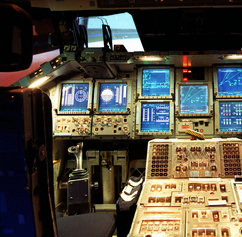
It may have flown faster, higher, and farther, but look inside the Space Shuttle cockpit and
you'll find the very same stick-and-rudder control system...
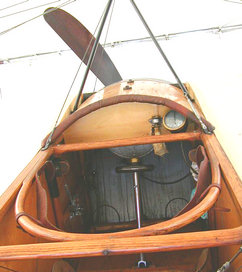
...developed by Louis Bleriot and Robert Esnault-Pelterie for the
Bleriot VIII in 1908.
(Note: The photo shows a 1909
Bleriot XI cockpit -- the two aircraft had almost identical
controls.)
|
Ferdinand Ferber, a captain in the French army, was
experimenting with Lilienthal-type gliders in 1899 at a time when
most of his flight-minded contemporaries had abandoned airplanes for
dirigibles. After hearing of the Wright brothers' work in 1902, he
built rude copies of their gliders. He had little success at first,
but when he moved the elevator to the rear to create a horizontal
tail, his gliders became more stable and flights more satisfactory.
Later, he collaborated with the Voisons to help design their first
successful aircraft. His most important contribution, however, was
his passion and enthusiasm for fixed-wing flight and his
determination to persuade his fellow Frenchmen to see its
possibilities.
|
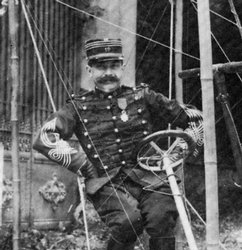
Ferdinand Ferber.
|
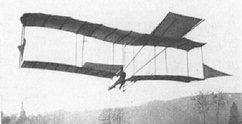
Gabriel Voison flies Ferber's tail-in-back glider in 1904. The
triangular surfaces on the ends of the wings serve as rudders.
|
Alberto Santos Dumont, a renowned Brazilian aeronaut residing
in France, was among the first to follow Ferber's advice. After
hearing tales of the Wrights' accomplishments, he set aside his
dirigibles and
began work on both a helicopter and an aircraft. He abandoned his
helicopter but his aircraft, the 14 Bis, flew on 23
October 1906 for a little over 200 feet (60 meters) and then again
on 12 November 1906 for 726 feet (220 meters), the first powered
flights in Europe. These events
galvanized Europe and fixed-wing flight research began in earnest.
Later Santos Dumont designed the Demoiselle, a popular
monoplane considered by many to be the first ultralight.
|
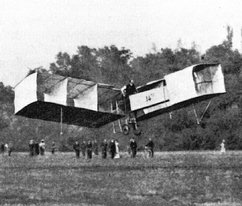
Santos Dumont pilots the 14 Bis
in October of 1906. The aircraft had no tail; the box-like surfaces
at the front of the aircraft -- the canard -- served as both
elevator and rudder.
|
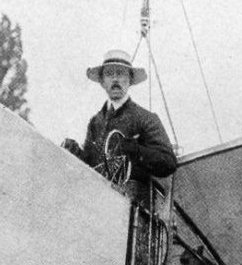
Alberto Santos Dumont.
|
Louis Bleriot, an inventor and manufacturer of automobile
headlamps, joined Gabriel Voison in 1905 to create the world's first
aircraft manufacturing firm. After two unsuccessful designs, the two
men split. Bleriot continued to build unsuccessful airplanes on his
own until he teamed with Raymond Saulnier in 1909 to produce
the
Bleriot XI. He became the first to fly across the English
Channel on 25 July 1909, giving his fledging airplane company a
much-needed shot in the arm. The wide popularity of the Bleriot
XI helped firmly establish the advantages of the "tractor"
(engine first, tail last) configuration. Bleriot also helped to
develop the standard stick-and-rudder control system still in use
today.
|
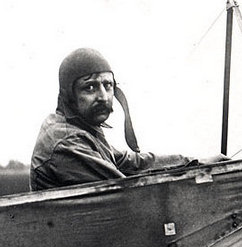
Louis Bleriot.
|
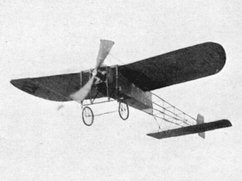
The Bleriot XI not only was
the first airplane to cross a large body of water (the English
Channel), it was also the first European airplane to be used for a
military campaign (1911) and the first ever for aerobatics (1913).
|
Charles and Gabriel Voison
partnered to build airplanes in 1906, shortly after Gabriel had
split with Louis Bleriot and dissolved their aircraft manufacturing
endeavor. The brothers established an
aircraft factory in Billancourt, France, making airplanes to
order. In 1907, they made two successful aircraft, one for
Leon Delagrange and another for Henri Farman. Although similar to
Wright aircraft in configuration, Voison machines had tails with
both horizontal and vertical stabilizing surfaces. With these
airplanes, Delagrange was able to make repeated flights up to 1650
feet (500 meters) and Farman flew a full kilometer (about 5/8 mile)
making a complete 360-degree turn.
|
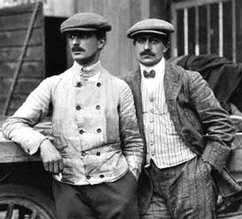
Gabriel (left) and Charles (right) Voison.
|
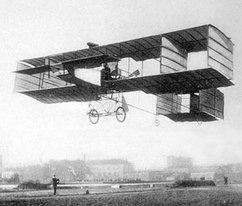
When the Voison-Delagrange aircraft first flew in early 1907 , it
looked like a Wright airplane married to a huge box-kite tail. Over
the year, it evolved to have a single surface elevator, dihedral
wings with side curtains, and a much smaller tail.
|
Glenn Curtiss was a motorcycle manufacturer when built his
first airplane, the June Bug, for the Aerial Experimentation
Association in 1908. That same year he won the Scientific American
Trophy for being first to fly a kilometer (officially). He soon
became a major force in the early aviation industry, popularizing
the use of ailerons for roll control, developing pontoons and the
flying boat, and building the first American airplane to be used in
a military campaign (the JN-3). The Curtiss OX-5 was the
first mass-produced aviation engine, powering a generation of light
aircraft.
|
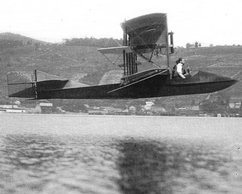
The Curtiss Model E was the first successful flying boat. Note the
ailerons mounted between the wings.
|
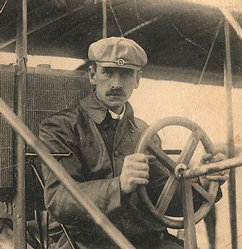
Glenn H. Curtiss.
|
Geoffrey DeHavilland built his first airplane in 1909,
wrecked it, then sold his second to the British War Office. He
joined the Royal Aircraft Factory in 1911 and within a year had
produced two historically important aircraft, the B.E.1 and
the B.E.2. The B.E. 1, with it's tractor configuration and
enclosed fuselage, was the first of the "second generation"
aircraft and as such marked the beginning of the end for the pioneer
era of aviation. The B.E.2, after some modifications became
the first inherently stable aircraft, a crucial
characteristic for all general and commercial aircraft.
|
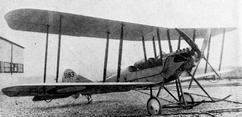
The Royal Aircraft Factory B.E.2c,
first test-flown in 1912, is considered by many
aviation historians to be the prototype for all World War I
fighters. "B.E." stood for "Bleriot Experimental." During this
period, the tractor configuration was sometimes referred to as the
"Bleriot" configuration, since Bleriot had done so much pioneering
work to refine the design.
|
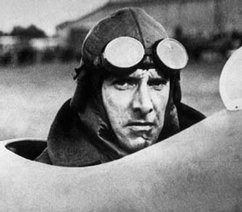
Geoffrey DeHavilland.
|
|
|
|

